Madame Weigel’s Journal of Fashion became a staple of Australian life for those interested in being well dressed, well presented, and well informed. The publication was the first of its kind in Australasia providing woman across the region with fashion reviews, advice on deportment, serialised fiction, news, recipes, travelogues and tidbits from Madame Weigel’s own life, and most importantly the free sewing pattern.1
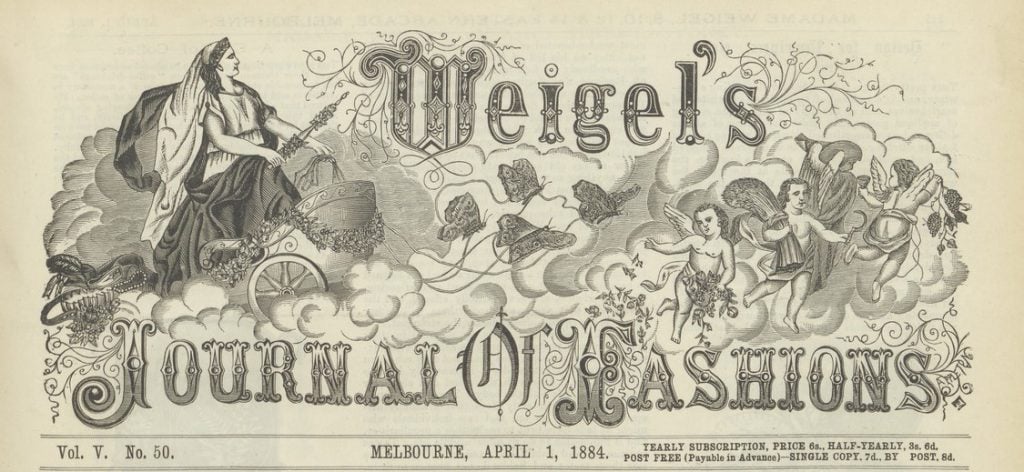
The journal was born from Johanna Weigel’s series of cut paper patterns for sewing at home, which first began publication and distribution in 1878 and continued for 90 years. Weigel’s journal, first published in 1880, ran for 70 years and turned Madame Weigel into a household name. These widely distributed paper patterns were the first commercially produced patterns available in Australia, and they became the backbone of fashion and sewing for over 90 years.2
The treasure trove that is Madame Weigel’s life’s work has recently be digitised and made available online as part of State Library Victoria’s Digitised journals, magazines and directories collection. Of the 70 year life span of Madame Weigel’s Journal of Fashion State Library Victoria has collected and digitised 66 years of material, from 1884 to 1950 making over 780 digitised journals.
Migrant and entrepreneur

Madam Weigel, born Johanna Wilhelmine Astmann was born in Prussia (now Poland) on February 11th, 1847.3 Johanna was immensely well-travelled, both as a migrant and later as an insatiable tourist.
She migrated to Vienna in 1863 after a family tragedy left her abandoned and fending for herself at the age of 16.4 While staying with her Godmother she used her prior education to translate French and German articles into English and submitted them to a well-known New York magazine.5
In August of 1872 at the age of 25 she made the arduous trip to New York with the promise of work as a fashion designer for the renowned paper pattern company McCalls.6
Finally, in 1877 Johanna moved to Melbourne with her newly acquired husband (1875) Oscar.7
Johanna and Oscar wasted no time in setting up their printing and distribution business in Australia.8 As the Weigel’s launched their enterprise it was clear that they made a formidable team, and their complementary skills enabled their ongoing success. Johanna was talented in pattern cutting, journalism, and publishing, while Oscar had skills in printing, engraving and machinery.9
Timeline of known major events in the life and business of Madam Weigel (left)10
The paper pattern market was a fledgling industry when the Weigel’s arrived in Australia. While sewing machines were a household staple for many, most woman made do with the skills passed down from relatives and by copying existing clothing.11 With such little competition it is almost no wonder that Madame Weigel prevailed in such a market. However, it would not have been so without her understanding of how valuable newspaper advertising and agency networks were to a business in gaining representation, especially across a land as vast and as unconnected as Australia.12
Madame Weigel began selling patterns that came with promises of the latest fashions from across Europe, although the evidence of these links to fashion on the other side of the world are still unclear.
These Patterns are exactly and accurately cut, are of the NEWEST and BEST STYLES, being derived from the most fashionable Houses of NEW YORK, LONDON, PARIS, and BERLIN, with which MADAME WEIGEL stands in correspondence.13
Her popularity, and the novelty of sewing something new required a rapid transfer to mass production. Within one year of arriving in Australia the Weigel’s had opened their first retail space in Melbourne, allowing people to directly purchase patterns, fifteen months later they opened a second shop in Sydney.14 The circular evolved into Madam Weigel’s Catalogue of Fashion, published less frequently than Weigel’s journal the catalogue showed all the patterns for a season and were mostly used by her agents and retailers to promote the available collection.15

Lady traveller
Travelling was incredibly important for Madame Weigel as it brought with it new inspiration, new fashions and new ideas to print, especially when presented to an Australian audience. In the decades that follow the successful establishment of Weigel’s Journal of Fashion Johanna spent multiple years out of the country on various tours. In 1893 the Weigel’s departed on a fourteen-month tour of Europe, visiting Italy, Germany, England, France, and Monaco.16 In 1905 Madame Weigel began a three-year long tour through Asia and Europe that included Ceylon (Sri Lanka), China, and Japan.17
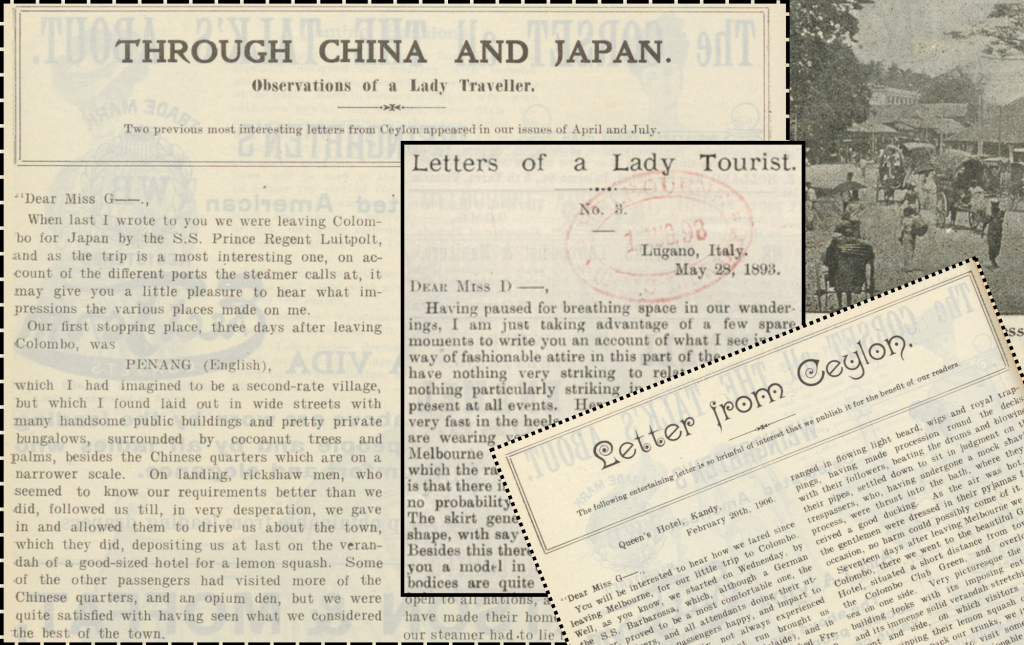
Through China and Japan August 1906, p 252
Letters of a Lady Tourist August 1893, p 83
Letter from Ceylon April 1906, p 76
Madame Weigel was one of the first published female travel loggers in Australia18, she was diligent in her letter writing to the Editor in charge of Weigel’s Journal originally a Miss D-, and later a Miss G-. Her missives where frequently printed for the readers to enjoy and to give her insights on fashion abroad, advice on travelling and her impressions of other countries. Between these travels and the continual development and running of the business that was Madame Weigel’s 22 years passed without incident. However, in 1915 during the Weigel’s longest tour the eruption of war and the death of Oscar changed the life of the woman, and the Journal forever.
Madame Weigel through WWI
Little is known about Oscar’s death, however official records revealed that he passed away on the 7th of February 1915 in Los Angeles California USA from acute Uraemia, and chronic Nephritis at the age of 70.19 Madam Weigel’s letters stop in Berlin in 1912, but her path was loosely followable due to letters published in Weigel’s journal.20 and ship records21 It is suspected that these letters were written and sent by Madame Weigel’s Ladies Maid, Sarah Neilson.22 The Weigel’s managed to find passage from England at the start of the war and fled across the Atlantic to America. Given Oscar’s German origin and Johanna’s Polish roots the two were heavily scrutinised and waylaid despite their Australian naturalisation and long-standing business success.23
While a notice of Oscar’s death was never published in the Weigel’s Journal, there were signs that indicated the change. The most notable of which was “Weigel’s Journal of Fashion” officially became “Madame Weigel’s Journal of Fashion” in September 1915, seven months after Oscar’s passing.24 After the loss of her husband and business partner Johanna largely disappeared for the remainder of the decade.

The years surrounding the war were difficult for Madame Weigel’s Journal of Fashion, as anti-German sentiment was at a record high. However, despite the anti-German sentiment and the general penny-pinching that occurred in response to the war the journal still sold one-million patterns per year in 1916.25 With a population of around five-million people at the time, her patterns were reaching one in five people26. Weigel’s journal, and the paper patterns always had a lean towards the practical but with the fast change in fashion due to the lack of material available, Madame Weigel’s had to adapt to maintain its reputation as the go-to for affordable fashions and household advice.
A new decade
Entering a new decade and now in her 70’s the esteemed Madame Weigel embraced much of the freedom that came with the 1920s. The designs featured in the journal and available by patterns became straighter, with dropped waists and higher hems. Fashion drawings also showed the changes, depicted with shorter hairstyles, cloche hats, and more relaxed postures.
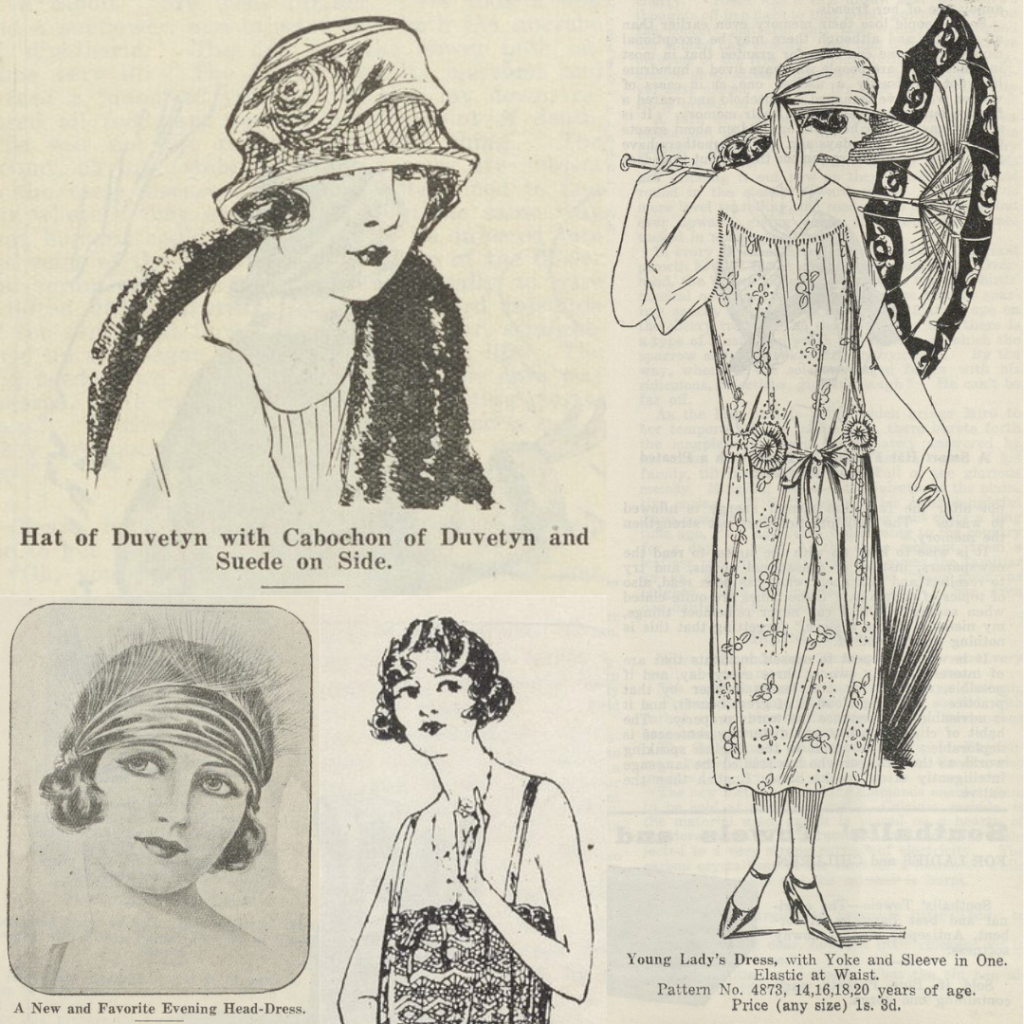
Hat of Duvetyn with Cabochon of Duvetyn and Suede on Side, July 1923, p 180
A New and Favorite Evening Head-Dress, February 1923, p 428
Head and torso image depicting short hair and lace garments, March 1924, p 24
Young Lady’s Dress, with Yoke and Sleeve in One, October 1924, p 317
The 1920s also saw the return of Madame Weigel’s travelogues as she travelled widely throughout America, Canada, Europe, and Australia. Aside from her travel letters, much of Madame Weigel’s writing often went unsigned when published among other articles printed in the journal.27 This however changed during the 1920s as her work across a wide range of topics began to be initialled J.W. or J.W.W.
Madame Weigel wrote about fashion, shopping, shoes, and hats, on topics from how to shop sensibly to the importance of dressing appropriately. She would often delve into modern topics, supporting the freedom that young women were experiencing while also managing to disapprove of behaviours she saw of as reckless or vulgar such as dancing with such rapid movements as to impede conversation. Fair to say that she was not a fan of the Charleston!
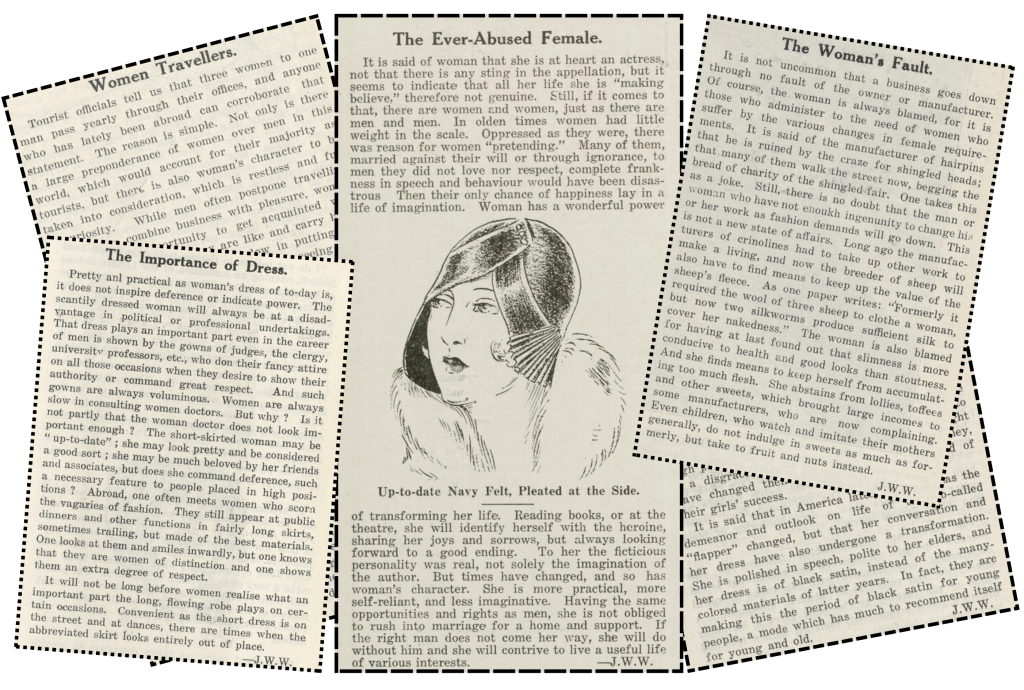
Woman Travellers, December 1929, p 401
The Importance of Dress, October 1926, p 319
The Ever-Abused Female, June 1929, p 134
The Woman’s Fault, September 1928, p 274
The Flapper Transformed, July 1928, p 182
Madame Weigel wrote on the topics of health, exercise, disease, diet and weight, she wrote about marriage, and motherhood despite never having children of her own. She discussed work, business, and the independence and self-sufficiency that a woman could gain by being able to work and choose a husband at her own leisure. As a self-made fashion mogul, she had much experience and strongly held opinions in this area. With her own years advancing and a life well lived Madame Weigel wrote on aging, advocating for ongoing social connection, aging gracefully, and being lenient to the younger generations.
Final chapter
The 1930s saw the arrival of the great depression and Madame Weigel’s Journal of Fashion once again had to weather the storm of tightening belts. With an eye to thrift Madame Weigel’s turned to making-do and mending with advice on darning, patching and dyeing as well as remaking and remodeling clothing to get the most life out of each available scrap. It was also during the 1930’s that the craft craze began with knitting and crochet patterns taking over the pages of Madame Weigel’s and allowing woman to make their own blankets and tea cozies, along with an array of gift giving options on a tight budget.28
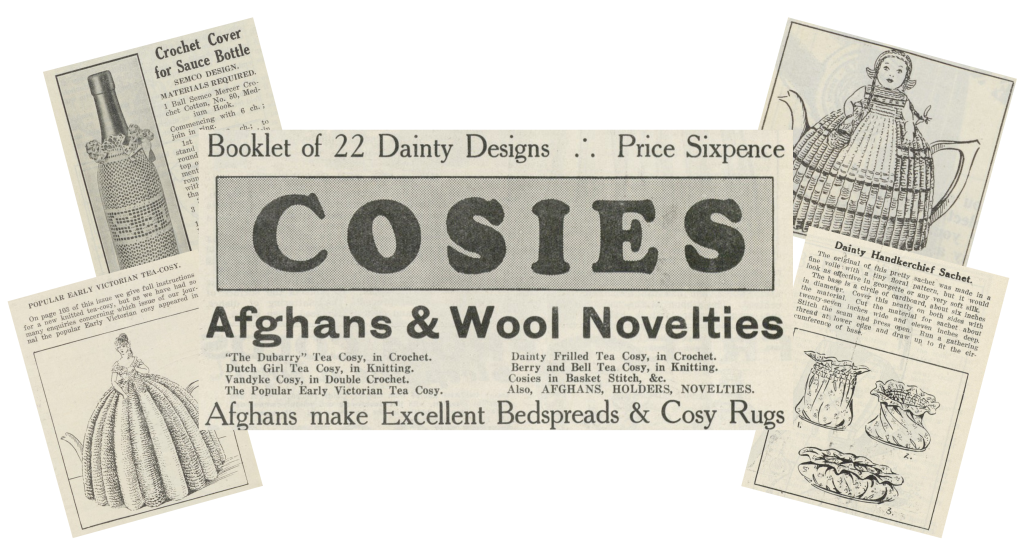
Crochet Cover for Sauce Bottle, October 1931, p 285
Early Victorian Tea-Cosy, May 1931, p 82
Cosies Advertisement, August 1934, p 209
Dutch Girl Tea Cosy, February 1934, p 451
Dainty Handkerchief Sachet, May 1935, p 107
Having stepped back from the publication of her journal by this time Madame Weigel now in her 80s moved from the home that she had shared with her husband to a hotel in Collins Street where she would live until her death in January of 1940, one month and one day shy of her 93rd birthday. The death of Madame Johanna Wilhelmine Weigel was announced in the 1940 February edition of Madame Weigel’s Journal of Fashion with a full page spread discussing her life and work.29 In the same issue Madame Weigel’s Journal of Fashion celebrated its Diamond Jubilee, completing 60 years of publication.30
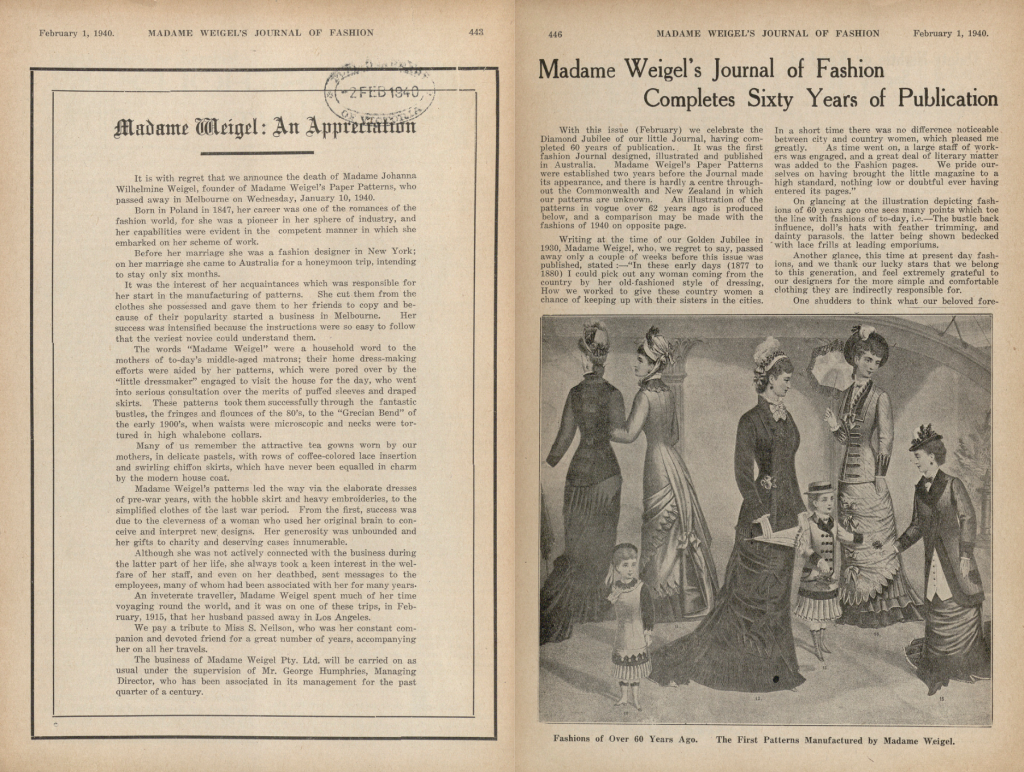
Madame Weigel’s legacy lived on for several years after her passing. Her journal continued until 1950 under the hand of many trusted employees, including the managing director Mr. George Humphries.31 Her paper pattern business continued publishing until 1969 when it closed its doors for the last time. With the increase in popularity, and affordability of the ready-to-wear clothing market, the need for homemade fashions steadily fell until it became the realm of the hobbyist. Now only the truly dedicated enthusiast knows the historic gold that they have hiding in their grandmothers sewing cabinet.
Further reading
Joy, S, M, 2004, Oscar and Johanna Weigel : proprietors of “Weigel’s Journal of Fashions” and creators of Madame Weigel’s paper dress patterns, S M Joy, Sandringham, Victoria
Lampkin, V, R, 2015, Madame Weigel : the woman who clothed the Australasian colonies, V R Lampkin, Carrara, Queensland
Lampkin, V, R, 2015, madameweigel.patterns, Instagram, Australia
Lampkin, V, R, 2020, Madame Weigel’s patterns : 1878-1950, V R Lampkin, Southport, Queensland
Lampkin, V, R, 2020, Madame Weigel’s sleeve patterns : arms, shoulders, elbows, wrists, hands (1878-1950), V R Lampkin, Southport, Queensland
Patterns of the Past: A mysterious fashion entrepreneur and her place in rural women’s history, 2021, video recording, Australian Broadcasting Corporation, Queensland, Australia, viewed 24/09/2024
<https://www.abc.net.au/news/rural/programs/landline/2021-08-29/patterns-of-the-past:-a-mysterious-fashion/13519088>
Madame Weigel: An exciting discovery for country museum, 2022, video recording, Australian Broadcasting Corporation, Queensland, Australia, viewed 24/09/2024 <https://www.abc.net.au/news/rural/programs/landline/2022-05-14/madame-weigel:-an-exciting-discovery-for-country/13882426>
References
- Lampkin, V, R, 2015, Madame Weigel : the woman who clothed the Australasian colonies, Carrara, Queensland, p 1
- As above, p 48
- As above, p 9
- As above, p 11
- As above, pp 13-14
- As above, pp 23-25
- As Above, p 27
- As above, p 48
- As above, p 59
- Harlow, C, 2024, Madame Weigel Timeline, Melbourne, Victoria
- Lampkin, V, R, 2015, Madame Weigel : the woman who clothed the Australasian colonies, Carrara, Queensland, p 48
- As above, pp 48-49, 57
- Joy, S, M, 2004, Oscar and Johanna Weigel : proprietors of “Weigel’s Journal of Fashions” and creators of Madame Weigel’s paper dress patterns, Sandringham, Victoria, p 82
- Lampkin, V, R, 2015, Madame Weigel : the woman who clothed the Australasian colonies, Carrara, Queensland, p 52
- As above, p 58
- As above, pp 74-89
- As above, pp 103-121
- As Above, p 75
- Joy, S, M, 2004, Oscar and Johanna Weigel : proprietors of “Weigel’s Journal of Fashions” and creators of Madame Weigel’s paper dress patterns, Sandringham, Victoria, pp 46, 47
- 1914, Madame Weigel’s Journal of Fashion, Vol. 35, No. 417 p 362
- Lampkin, V, R, 2015, Madame Weigel : the woman who clothed the Australasian colonies, Carrara, Queensland, p 141
- As above, pp 139-140
- As above, pp 140-143, 146-147
- 1915, Madame Weigel’s Journal of Fashion, Vol. 36, No. 427
- Lampkin, V, R, 2015, Madame Weigel : the woman who clothed the Australasian colonies, Carrara, Queensland, p 4
- As above, p 4
- As above, p 200
- As above, p 220
- 1940, Madame Weigel’s Journal of Fashion, Vol. 60, No. 720 p 443
- As above p 446
- As above, p 443


Thanks Clare for sharing this story, so inspiring and fascinating at the same time.
Great to see the timelines and the little nuggets and photos… This may have been one of the first and original influencers of the past. Loved it!
Thank you Joey. I quite enjoyed following the life of such a courageous and unique woman, and very much agree with your conclusion!
This is so interesting! I desperately want to find and make one of her patterns! Does the Library have digital copies?
Thank you George. Unfortunately, State library Victoria does not currently hold any of Madame Weigel’s patterns at this time. Their ephemeral nature means that not many have survived, and they can be quite hard to come by in a preserved state. Good luck in your search!
Outstanding work on the digitisation of this fine collection. Congratulations to all involved. For the social history enthusiasts out there, ‘Weigel’s Journal of Fashion’ was mentioned several times by ‘Sappho Smith’ [Alexina Maude (Ina) Wildman 1867–1896] who wrote the popular ‘My Dear Moorabinda’ column for The Bulletin 1888-1896 before her early death at 28. Her droll observations about high-society fashionistas in colonial Sydney and their fashion choices—good and/or bad—are often highly amusing. Those interested in Australian fashion history are new well served by the Weigel archive. See https://adb.anu.edu.au/biography/wildman-alexina-maude-ina-9095